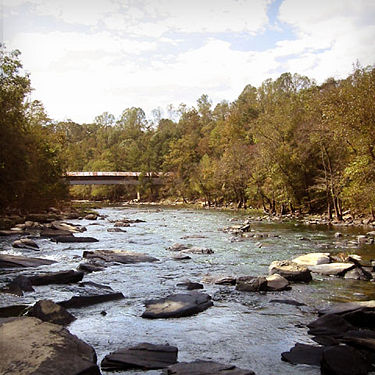Swann Bridge: Difference between revisions
No edit summary |
No edit summary |
||
| Line 1: | Line 1: | ||
[[Image:Swann Bridge.JPG|right|thumb| | [[Image:Swann Bridge.JPG|right|thumb|375px|Swann Bridge in September 2004]] | ||
The '''Swann Bridge''' (sometimes called '''Joy Bridge''' or '''Swann-Joy Bridge''') is, at 324 feet, the longest covered bridge in Alabama. Completed in [[1933]] with its roadbed about 27 feet above the water, the triple-span traverses the waters of the [[Locust Fork River|Locust Fork]] of the [[Black Warrior River]] just below [[Bullard Shoal]]. | The '''Swann Bridge''' (sometimes called '''Joy Bridge''' or '''Swann-Joy Bridge''') is, at 324 feet, the longest covered bridge in Alabama. Completed in [[1933]] with its roadbed about 27 feet above the water, the triple-span traverses the waters of the [[Locust Fork River|Locust Fork]] of the [[Black Warrior River]] just below [[Bullard Shoal]]. The bridge was constructed to provide access to the [[Joy]] community from [[Swann Farm]]. | ||
Swann Bridge is located on [[Swann Bridge Road]] near [[Alabama Highway 79]] just west of [[Cleveland]]. it is one of three remaining covered bridges in Blount County, all built by brothers [[Forrest Tidwell|Forrest]] and [[Zelmer | Swann Bridge is located on [[Swann Bridge Road]] near [[Alabama Highway 79]] just west of [[Cleveland]]. it is one of three remaining covered bridges in Blount County, all built by brothers [[Forrest Tidwell|Forrest]] and [[Zelmer Tidwell]]. Tidwell earned $2.75 per day for his efforts, while his carpenters earned $1.75 and his laborers $1.25. The lumbers was supplied for $14 per 1000 board feet. | ||
Like their other bridges, the timber frame is constructed in the "Town lattice truss" style, using small pieces pegged together to form the structural walls on either side of the 14 foot-wide roadway. The intermediate piers are constructed of concrete. The original wood-shingle roof has been replaced by galvanized metal. | |||
A network of trails on the western side lead to the stream banks below. Not far downstream from the bridge a stone cliff has been carved by the river. The area is popular with picnickers and ATV riders. | |||
Blount County has been working to secure funding for structural analysis and conservation of its three covered bridges and may begin accepting bids in early [[2009]]. | Blount County has been working to secure funding for structural analysis and conservation of its three covered bridges and may begin accepting bids in early [[2009]]. | ||
==References== | ==References== | ||
* {{Prince-1981}} | |||
* University of Alabama Center for Public Television and Radio. ''Bridges to the Past''. | * University of Alabama Center for Public Television and Radio. ''Bridges to the Past''. | ||
Revision as of 19:20, 2 March 2011
The Swann Bridge (sometimes called Joy Bridge or Swann-Joy Bridge) is, at 324 feet, the longest covered bridge in Alabama. Completed in 1933 with its roadbed about 27 feet above the water, the triple-span traverses the waters of the Locust Fork of the Black Warrior River just below Bullard Shoal. The bridge was constructed to provide access to the Joy community from Swann Farm.
Swann Bridge is located on Swann Bridge Road near Alabama Highway 79 just west of Cleveland. it is one of three remaining covered bridges in Blount County, all built by brothers Forrest and Zelmer Tidwell. Tidwell earned $2.75 per day for his efforts, while his carpenters earned $1.75 and his laborers $1.25. The lumbers was supplied for $14 per 1000 board feet.
Like their other bridges, the timber frame is constructed in the "Town lattice truss" style, using small pieces pegged together to form the structural walls on either side of the 14 foot-wide roadway. The intermediate piers are constructed of concrete. The original wood-shingle roof has been replaced by galvanized metal.
A network of trails on the western side lead to the stream banks below. Not far downstream from the bridge a stone cliff has been carved by the river. The area is popular with picnickers and ATV riders.
Blount County has been working to secure funding for structural analysis and conservation of its three covered bridges and may begin accepting bids in early 2009.
References
- Prince, A. G. (1981) Alabama's Covered Bridges: Past and Present. revised edition. Ensley: Best Printing Service
- University of Alabama Center for Public Television and Radio. Bridges to the Past.
